Carbon Emissions and Its Efficiency of Tourist Hotels in China from the Supply Chain Based on the Input–Output Method and Super-SBM Model
Abstract
:1. Introduction
2. The Literature Review
2.1. Carbon Emissions and Efficiency of Hotels
2.2. Input–Output Model for Carbon Emissions
3. Methodology
3.1. Calculation of Carbon Emissions
3.1.1. Direct Carbon Emissions
3.1.2. Total Carbon Emissions and Indirect Carbon Emissions
3.2. Coupling Analysis of Carbon Emissions and Income
3.3. Assessment of the Carbon Emission Efficiency: Super-SBM Non-Oriented Model
3.4. Driving Factors
3.4.1. Internal Driving Factor Analysis-Panel Tobit Analysis
3.4.2. External Driving Factor Analysis-Geographic Detector
3.5. Indicators and Data
3.5.1. Indicators for Carbon Emissions Efficiency Assessments
3.5.2. Regression Model Indicator Selection
3.5.3. Selection of Geographic Detector Indicators
3.5.4. Data Sources
4. Results and Analysis
4.1. Carbon Emission Trend
4.2. Characteristics of the Spatial Distribution of Direct Carbon Emissions and Indirect Carbon Emissions
4.3. Indirect Carbon Emission Source Analysis
4.4. Coupling Analysis of Carbon Emissions and Economic Value
4.5. Carbon Emission Efficiency of Tourist Hotels
4.6. Driving Factors Analysis
4.6.1. Analysis of the Internal Driving Factor Results
4.6.2. Analysis of External Driving Factor Results
5. Discussion
6. Implications
7. Determinants and Future Studies
Author Contributions
Funding
Institutional Review Board Statement
Informed Consent Statement
Data Availability Statement
Acknowledgments
Conflicts of Interest
References
- Vrkljan, S.; Barisic, P.; Vrenc, K. Analysis of Seasonality Impact on the Business Performance of Global Chain Hotels. In Proceedings of the 5th International Scientific Conference on Tourism in Southern and Eastern Europe (ToSEE 2019), Opatija, Croatia, 16–18 May 2019. [Google Scholar]
- Gregory, D.; Jennifer, S. The Influence of Occupancy Change on Hotel Market Equilibrium. Cornell Hosp. Q. 2021, 62, 426–437. [Google Scholar]
- Forster, P.M.; Smith, C.; Walsh, T.; Lamb, W.F.; Lamboll, R.; Hall, B.; Hauser, M.; Ribes, A.; Rosen, D.; Gillett, N.P.; et al. Indicators of Global Climate Change 2023: Annual update of key indicators of the state of the climate system and human influence. Earth Syst. Sci. Data 2024, 16, 2625–2658. [Google Scholar] [CrossRef]
- Xu, X.; Liu, K. Knowledge mapping of energy research in the hospitality industry to evaluation research collaboration. Heliyon 2023, 9, e16591. [Google Scholar] [CrossRef]
- UNWTO. Tourism Data: The UN Tourism Data Dashboard. 2024. Available online: https://www.unwto.org/ (accessed on 27 October 2024).
- Spiller, M.; Müller, C.; Mulholland, Z.; Louizidou, P.; Küpper, F.C.; Knosala, K.; Stenzel, P. Reducing Carbon Emissions from the Tourist Accommodation Sector on Non-Interconnected Islands: A Case Study of a Medium-Sized Hotel in Rhodes, Greece. Energies 2022, 15, 3801. [Google Scholar] [CrossRef]
- Wu, J.; Liang, L. A DEA model for identifying critical input-output performance measures. J. Syst. Sci. Complex. 2012, 25, 275–286. [Google Scholar] [CrossRef]
- Lenzen, M.; Sun, Y.Y.; Faturay, F.; Ting, Y.P.; Geschke, A.; Malik, A. The carbon footprint of global tourism. Nat. Clim. Change 2018, 8, 522–528. [Google Scholar] [CrossRef]
- Sun, W.; Huang, C. Predictions of carbon emission intensity based on factor analysis and an improved extreme learning machine from the perspective of carbon emission efficiency. J. Clean. Prod. 2022, 338, 130414. [Google Scholar] [CrossRef]
- Wang, Q.-C.; Ren, Y.-T.; Liu, X.; Chang, R.-D.; Zuo, J. Exploring the heterogeneity in drivers of energy-saving behaviours among hotel guests: Insights from the theory of planned behaviour and personality profiles. Environ. Impact Assess. Rev. 2023, 99, 107012. [Google Scholar] [CrossRef]
- Gao, P.; Yue, S.J.; Chen, H.T. Carbon emission efficiency of China’s industry sectors: From the perspective of embodied carbon emissions. J. Clean. Prod. 2021, 283, 124655. [Google Scholar] [CrossRef]
- Liu, X.; Wider, W.; Fauzi, M.A.; Jiang, L.; Udang, L.N.; Hossain, S.F.A. The evolution of smart hotels: A bibliometric review of the past, present and future trends. Heliyon 2024, 10, e26472. [Google Scholar] [CrossRef]
- The Ministry of Culture and Tourism in China. Statistical Investigation Report on 2023 Annual Star-Rated Tourist Hotels. 2024. Available online: https://zwgk.mct.gov.cn/zfxxgkml/tjxx/202404/t20240430_952645.html (accessed on 27 October 2024).
- Zhang, D.D.; Li, H.Y.; Zhu, H.Y.; Zhang, H.C.; Goh, H.H.; Wong, M.C.; Wu, T. Impact of COVID-19 on Urban Energy Consumption of Commercial Tourism City. Sustain. Cities Soc. 2021, 73, 103133. [Google Scholar] [CrossRef] [PubMed]
- Shang, Y.; Zhu, L.; Qian, F.; Xie, Y. Role of green finance in renewable energy development in the tourism sector. Renew. Energy 2023, 206, 890–896. [Google Scholar] [CrossRef]
- Perez, F.J.D.; Chinarro, D.; Mouhaffel, A.G.; Martin, R.D.; Otin, M.R.P. Comparative study of carbon footprint of energy and water in hotels of Canary Islands regarding mainland Spain. Environ. Dev. Sustain. 2019, 21, 1763–1780. [Google Scholar] [CrossRef]
- Koiwanit, J.; Filimonau, V. Carbon footprint assessment of home-stays in Thailand. Resour. Conserv. Recycl. 2021, 164, 105123. [Google Scholar] [CrossRef]
- Long, Y.; Yoshida, Y.; Dong, L. Exploring the indirect household carbon emissions by source: Analysis on 49 Japanese cities. J. Clean. Prod. 2017, 167, 571–581. [Google Scholar] [CrossRef]
- Torres, S.G.M.; Tzuc, O.M.; Aguilar-Castro, K.M.; Tellez, M.C.; Sierra, J.O.; Cruz, A.; Barrera-Lao, F.J. Analysis of Energy and Environmental Indicators for Sustainable Operation of Mexican Hotels in Tropical Climate Aided by Artificial Intelligence. Buildings 2022, 12, 1155. [Google Scholar] [CrossRef]
- Filimonau, V.; Santa Rosa, M.; Franca, L.S.; Creus, A.C.; Ribeiro, G.M.; Molnarova, J.; Piumatti, R.G.; Valsasina, L.; Safaei, A. Environmental and carbon footprint of tourist accommodation: A comparative study of popular hotel categories in Brazil and Peru. J. Clean. Prod. 2021, 328, 129561. [Google Scholar] [CrossRef]
- Triatmanto, B.; Respati, H.; Wahyuni, N. Towards an understanding of corporate image in the hospitality industry East Java, Indonesia. Heliyon 2021, 7, e06404. [Google Scholar] [CrossRef]
- Ali, Y.; Pretaroli, R.; Socci, C.; Severini, F. Carbon and water footprint accounts of Italy: A Multi-Region Input-Output approach. Renew. Sustain. Energy Rev. 2018, 81, 1813–1824. [Google Scholar] [CrossRef]
- Abeydeera, L.; Karunasena, G. Carbon Emissions of Hotels: The Case of the Sri Lankan Hotel Industry. Buildings 2019, 9, 227. [Google Scholar] [CrossRef]
- Salehi, M.; Filimonau, V.; Asadzadeh, M.; Ghaderi, E. Strategies to improve energy and carbon efficiency of luxury hotels in Iran. Sustain. Prod. Consum. 2021, 26, 1–15. [Google Scholar] [CrossRef]
- Qiu, J.; Guo, Z.R.; Sun, C.W. Carbon emission reduction calculation for the green transformation of traditional hotel design. Front. Energy Res. 2022, 10, 985336. [Google Scholar] [CrossRef]
- Gössling, S.; Peeters, P.; Ceron, J.-P.; Dubois, G.; Patterson, T.; Richardson, R.B. The eco-efficiency of tourism. Ecol. Econ. 2005, 54, 417–434. [Google Scholar] [CrossRef]
- Tang, Z.; Shang, J.; Shi, C. Estimation of Carbon Dioxide Emissions and Spatial Variation from Tourism Accommodation in China. Environ. Eng. Manag. J. 2013, 12, 1921–1925. [Google Scholar]
- Yang, S.; Wu, H.-T.; Huang, Y.-C. Analysis of Energy Use and Carbon Emission in the National Hotel Building. In Proceedings of the 5th International Workshop on Energy and Environment of Residential Buildings/3rd International Conference on Built Environment and Public Health, Guilin, China, 29–31 May 2009. [Google Scholar]
- Xia, B.; Dong, S.; Li, Z.; Zhao, M.; Sun, D.; Zhang, W.; Li, Y. Eco-Efficiency and Its Drivers in Tourism Sectors with Respect to Carbon Emissions from the Supply Chain: An Integrated EEIO and DEA Approach. Int. J. Environ. Res. Public Health 2022, 19, 6951. [Google Scholar] [CrossRef]
- Smitt, S.; Tolstorebrov, I.; Gullo, P.; Pardinas, A.; Hafner, A. Energy use and retrofitting potential of heat pumps in cold climate hotels. J. Clean. Prod. 2021, 298, 126799. [Google Scholar] [CrossRef]
- Becken, S.; Patterson, M. Measuring National Carbon Dioxide Emissions from Tourism as a Key Step Towards Achieving Sustainable Tourism. J. Sustain. Tour. 2009, 14, 323–338. [Google Scholar] [CrossRef]
- GB/T 14308-2023; Classification and Rating of Tourist Hotel Stars. China National Standards: Beijing, China, 2023.
- Jiachen, L.; Xue, L.; Chiyin, C. The CO2 Emission Efficiency of China’s Hotel Industry under the Double Carbon Objectives and Homestay Growth. Energies 2021, 14, 8228. [Google Scholar] [CrossRef]
- Liu, J.; Lin, C.; Huang, L.; Zhu, J.H.; Wu, L.J.; Li, Y.Y. Use of Household Survey Data as a Tool to Assess the Carbon Footprint of Rural Tourist Accommodation and Related Services in China: A Case Study of Mount Qingcheng. Sustainability 2017, 9, 1680. [Google Scholar] [CrossRef]
- Cadarso, M.A.; Gomez, N.; Lopez, L.A.; Tobarra, M.A. Calculating tourism’s carbon footprint: Measuring the impact of investments. J. Clean. Prod. 2016, 111, 529–537. [Google Scholar] [CrossRef]
- Chen, L.-F. Hotel chain affiliation as an environmental performance strategy for luxury hotels. Int. J. Hosp. Manag. 2019, 77, 1–6. [Google Scholar] [CrossRef]
- Chen, L.-F. Research note: A sustainable hypothesis for tourist hotels: Evidence from international hotel chains. Tour. Econ. 2013, 19, 1449–1460. [Google Scholar] [CrossRef]
- Ba, D.; Zhang, J.; Dong, S.; Xia, B.; Mu, L. Spatial-Temporal Characteristics and Driving Factors of the Eco-Efficiency of Tourist Hotels in China. Int. J. Environ. Res. Public Health 2022, 19, 11515. [Google Scholar] [CrossRef] [PubMed]
- Hu, A.H.; Huang, C.-Y.; Chen, C.-F.; Kuo, C.-H.; Hsu, C.-W. Assessing carbon footprint in the life cycle of accommodation services: The case of an international tourist hotel. Int. J. Sustain. Dev. World Ecol. 2015, 22, 313–323. [Google Scholar] [CrossRef]
- Salem, R.; Bahadori-Jahromi, A.; Mylona, A.; Godfrey, P.; Cook, D. Comparison and Evaluation of the Potential Energy, Carbon Emissions, and Financial Impacts from the Incorporation of CHP and CCHP Systems in Existing UK Hotel Buildings. Energies 2018, 11, 1219. [Google Scholar] [CrossRef]
- Sánchez-Sánchez, F.J.; Sánchez-Sánchez, A.M.; Pulido, N.; Borrero, D.V. A DEA Approach for Evaluating the Labor Efficiency in the Rural Hotel Industry: A Case Study in Spain. Tour. Int. Interdiscip. J. 2022, 70, 603–623. [Google Scholar] [CrossRef]
- Deng, Z.; Gao, Y.; Liang, B.; Morrison, A.M. Efficiency evaluation of hotel operations in China’s mainland based on the superefficiency SBM model. Tour. Econ. 2020, 26, 276–298. [Google Scholar] [CrossRef]
- Kitzes, J. An Introduction to Environmentally-Extended Input-Output Analysis. Resources 2013, 2, 489–503. [Google Scholar] [CrossRef]
- Foley, D.K.; Leontief, W. An interview with Wassily Leontief. Macroecon. Dyn. 1998, 2, 116–140. [Google Scholar] [CrossRef]
- Dietzenbacher, E.; Cazcarro, I.; Arto, I. Towards a more effective climate policy on international trade. Nat. Commun. 2020, 11, 1130. [Google Scholar] [CrossRef]
- Fang, D.; Hsueh, M.-C.; Chiu, C.-R. An investigation of international hotel productivity considering quasifixed inputs and negative outputs. Manag. Decis. Econ. 2020, 41, 380–388. [Google Scholar] [CrossRef]
- Yu, M.-M. An integration of the multi-component DEA and GAR models to the measurement of hotel performance. Curr. Issues Tour. 2012, 15, 461–476. [Google Scholar] [CrossRef]
- Lee, Y.-L.; Kuo, S.-H.; Jiang, M.-Y.; Li, Y. Evaluating the Performances of Taiwan’s International Tourist Hotels: Applying the Directional Distance Function and Meta-Frontier Approach. Sustainability 2019, 11, 5773. [Google Scholar] [CrossRef]
- Kurzweil, P.; Muller, A.; Wahler, S. The Ecological Footprint of COVID-19 mRNA Vaccines: Estimating Greenhouse Gas Emissions in Germany. Int. J. Environ. Res. Public Health 2021, 18, 12. [Google Scholar] [CrossRef]
- Sharp, H.; Grundius, J.; Heinonen, J. Carbon Footprint of Inbound Tourism to Iceland: A Consumption-Based Life-Cycle Assessment including Direct and Indirect Emissions. Sustainability 2016, 8, 1147. [Google Scholar] [CrossRef]
- Maraseni, T.N.; Qu, J.; Yue, B.; Zeng, J.; Maroulis, J. Dynamism of household carbon emissions (HCEs) from rural and urban regions of northern and southern China. Environ. Sci. Pollut. Res. 2016, 23, 20553–20566. [Google Scholar] [CrossRef]
- Merciai, S.; Heijungs, R. Balance issues in monetary input-output tables. Ecol. Econ. 2014, 102, 69–74. [Google Scholar] [CrossRef]
- Lach, L. Optimization based structural decomposition analysis as a tool for supporting environmental policymaking. Energy Econ. 2022, 115, 106332. [Google Scholar] [CrossRef]
- Ma, N.; Li, H.J.; Tang, R.W.; Dong, D.; Shi, J.L.; Wang, Z. Structural analysis of indirect carbon emissions embodied in intermediate input between Chinese sectors: A complex network approach. Environ. Sci. Pollut. Res. 2019, 26, 17591–17607. [Google Scholar] [CrossRef]
- Wang, Z.; Huo, F.; Xu, S. Coupled Development and Regional Differences between Tourism Industry and Tourism Environments in Hunan, Hubei, Chongqing and Guizhou. Econ. Geogr. 2018, 38, 204–213. [Google Scholar]
- Li, N.; Shi, B.B.; Kang, R. Analysis of the Coupling Effect and Space-Time Difference between China’s Digital Economy Development and Carbon Emissions Reduction. Int. J. Environ. Res. Public Health 2023, 20, 872. [Google Scholar] [CrossRef] [PubMed]
- Wang, H.; Wu, Y.; Zhu, N. Measurement and spatio-temporal heterogeneity analysis of coupling coordination between development of digital economy and agricultural carbon emission performance. PLoS ONE 2024, 19, e0305231. [Google Scholar] [CrossRef] [PubMed]
- Tone, K. A slacks-based measure of super-efficiency in data envelopment analysis. Eur. J. Oper. Res. 2002, 143, 32–41. [Google Scholar] [CrossRef]
- Lee, H.S. Integrating SBM model and Super-SBM model: A one-model approach. Omega-Int. J. Manag. Sci. 2022, 113, 102693. [Google Scholar] [CrossRef]
- Li, Z.; Chen, X.; Ye, Y.; Wang, F.; Liao, K.; Wang, C. The impact of digital economy on industrial carbon emission efficiency at the city level in China: Gravity movement trajectories and driving mechanisms. Environ. Technol. Innov. 2024, 33, 103511. [Google Scholar] [CrossRef]
- Chen, C.-M. Super efficiencies or super inefficiencies? Insights from a joint computation model for slacks-based measures in DEA. Eur. J. Oper. Res. 2013, 226, 258–267. [Google Scholar] [CrossRef]
- Costa, D.R.; Lachos, V.H.; Bazanc, J.L.; Azevedo, C.L.N. Estimation methods for multivariate Tobit confirmatory factor analysis. Comput. Stat. Data Anal. 2014, 79, 248–260. [Google Scholar] [CrossRef]
- Ke, G.; Yongbo, Y. Research on Spatial and Temporal Evolution Trends and Driving Factors of Green Residences in China Based on Weighted Standard Deviational Ellipse and Panel Tobit Model. Appl. Sci. 2022, 12, 8788. [Google Scholar] [CrossRef]
- Wang, J.; Xu, C. Geographic Detector: Principles and Prospects. J. Geogr. 2017, 72, 116–134. [Google Scholar]
- Wang, X.S.; Fu, Y. Some Characterizations of the Cobb-Douglas and CES Production Functions in Microeconomics. In Abstract and Applied Analysis; Hindawi Publishing Corporation: London, UK, 2013. [Google Scholar] [CrossRef]
- Xia, B.; Dong, S.C.; Li, Y.; Li, Z.H.; Sun, D.Q.; Zhang, W.B.; Li, W.L. Evolution Characters and Influencing Factors of Regional Eco-Efficiency in a Developing Country: Evidence from Mongolia. Int. J. Environ. Res. Public Health 2021, 18, 10719. [Google Scholar] [CrossRef]
- Liu, M.; Zhang, X.; Zhang, M.; Feng, Y.; Liu, Y.; Wen, J.; Liu, L. Influencing factors of carbon emissions in transportation industry based on C-D function and LMDI decomposition model: China as an example. Environ. Impact Assess. Rev. 2021, 90, 106623. [Google Scholar] [CrossRef]
- Ren, Y.F.; Fang, C.L.; Li, G.D. Spatiotemporal characteristics and influential factors of eco-efficiency in Chinese prefecture-level cities: A spatial panel econometric analysis. J. Clean. Prod. 2020, 260, 120787. [Google Scholar] [CrossRef]
- Sun, Y.; Qian, L.; Liu, Z. The carbon emissions level of China’s service industry: An analysis of characteristics and influencing factors. Environ. Dev. Sustain. 2022, 24, 13557–13582. [Google Scholar] [CrossRef]
- Meng, W.; Xu, L.; Hu, B.; Zhou, J.; Wang, Z. Quantifying direct and indirect carbon dioxide emissions of the Chinese tourism industry. J. Clean. Prod. 2016, 126, 586–594. [Google Scholar] [CrossRef]
- Svec, R.; Picha, K.; Martinat, S.; Navratil, J. Direct or indirect energy savings in food and beverage services? Visitors’ preferences in hotel restaurants. Heliyon 2023, 9, e17519. [Google Scholar] [CrossRef]
- Cao, F.K.; Xi, Y.; Zheng, C.; Bai, T.Y.; Sun, Q. How Efficient are Basic Public Health Services Between Urban and Rural in Shandong Province, China? A Data Envelopment Analysis and Panel Tobit Regression Approach. Risk Manag. Healthc. Policy 2022, 15, 727–738. [Google Scholar] [CrossRef]
- He, B.; Yuan, X.; Qian, S.; Li, B. Product low-carbon design, manufacturing, logistics, and recycling: An overview. Wiley Interdiscip. Rev.-Energy Environ. 2023, 12, e479. [Google Scholar] [CrossRef]
- Zhang, K.; Guo, S.; Liu, G. The impact of financial technology on China’s low-carbon transformation of energy and mechanism analysis. Environ. Sci. Pollut. Res. 2024, 31, 5190–5208. [Google Scholar] [CrossRef]
- Gu, W.; Zhao, X.H.; Yan, X.B.; Wang, C.; Li, Q. Energy technological progress, energy consumption, and CO2 emissions: Empirical evidence from China. J. Clean. Prod. 2019, 236, 117666. [Google Scholar] [CrossRef]
- Tang, Z.; Bai, S.Z.; Shi, C.B.; Liu, L.; Li, X.H. Tourism-Related CO2 Emission and Its Decoupling Effects in China: A Spatiotemporal Perspective. Adv. Meteorol. 2018, 2018, 1473184. [Google Scholar] [CrossRef]
- Mohammed, B.; Cynthia, A.; Imane, E.O. Do political and social factors affect carbon emissions? Evidence from international data. Appl. Econ. 2022, 54, 6022–6035. [Google Scholar]
- Bratanova, B.; Loughnan, S.; Klein, O.; Claassen, A.; Wood, R. Poverty, inequality, and increased consumption of high calorie food: Experimental evidence for a causal link. Appetite 2016, 100, 162–171. [Google Scholar] [CrossRef] [PubMed]
- Milindi, P.S.; De Lieto, F.; Chopra, S.S. Food waste-Energy-Water-Emissions (FEWE) nexus in the food service sector: Comparing a restaurant meal from imported ingredients versus an imported ready-to-eat meal. J. Clean. Prod. 2022, 380, 134871. [Google Scholar] [CrossRef]
- Ahmed, K.; Shahbaz, M.; Kyophilavong, P. Revisiting the emissions-energy-trade nexus: Evidence from the newly industrializing countries. Environ. Sci. Pollut. Res. 2016, 23, 7676–7691. [Google Scholar] [CrossRef]
- Dong, B.Y.; Xu, Y.Z.; Fan, X.M. How to achieve a win-win situation between economic growth and carbon emission reduction: Empirical evidence from the perspective of industrial structure upgrading. Environ. Sci. Pollut. Res. 2020, 27, 43829–43844. [Google Scholar] [CrossRef]
- Lin, Y.; Wu, D.; Chiu, C.-H. Impact of customer environmental attitude-behavior gap. J. Travel Tour. Mark. 2023, 40, 802–817. [Google Scholar] [CrossRef]
- Othman, R.; Abu Kasim, S.Z.; Hashim, K.S.H.-Y.; Baharuddin, Z.M.; Mahamod, L.H. Carbon Sequestration Rate Modelling System for Hotel and Resort Green Spaces. In Proceedings of the International Conference on Business, Management, Tourism and Hospitality (BIZMATOUR), Malacca, Malaysia, 12–14 May 2015. [Google Scholar]
- Jing, P.; Qiuyan, L. Research on Innovative Improvement of Hotel Catering Service Quality Based on Multifactor Data Analy-sis:Taking Zhejiang Jinhua Marriott Hotel as an Example. In Proceedings of the 2024 3rd International Conference on Humanities, Wisdom Education and Service Management (HWESM 2024), Hangzhou, China, 21–23 March 2024. [Google Scholar]
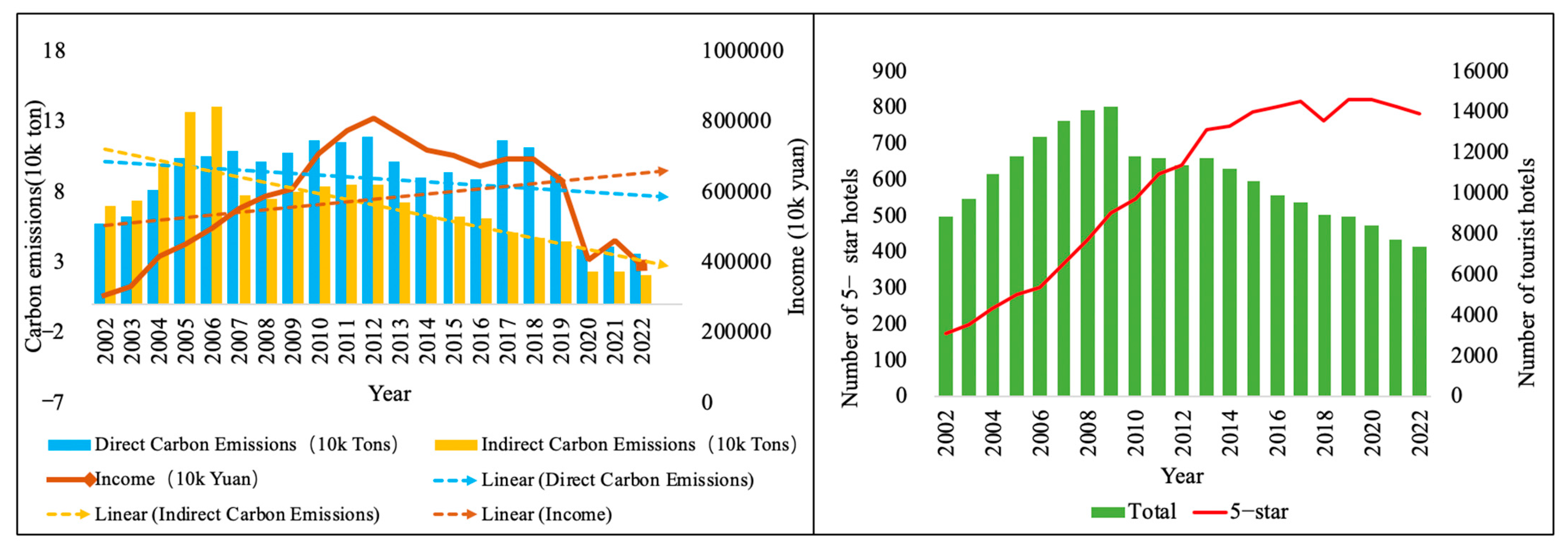
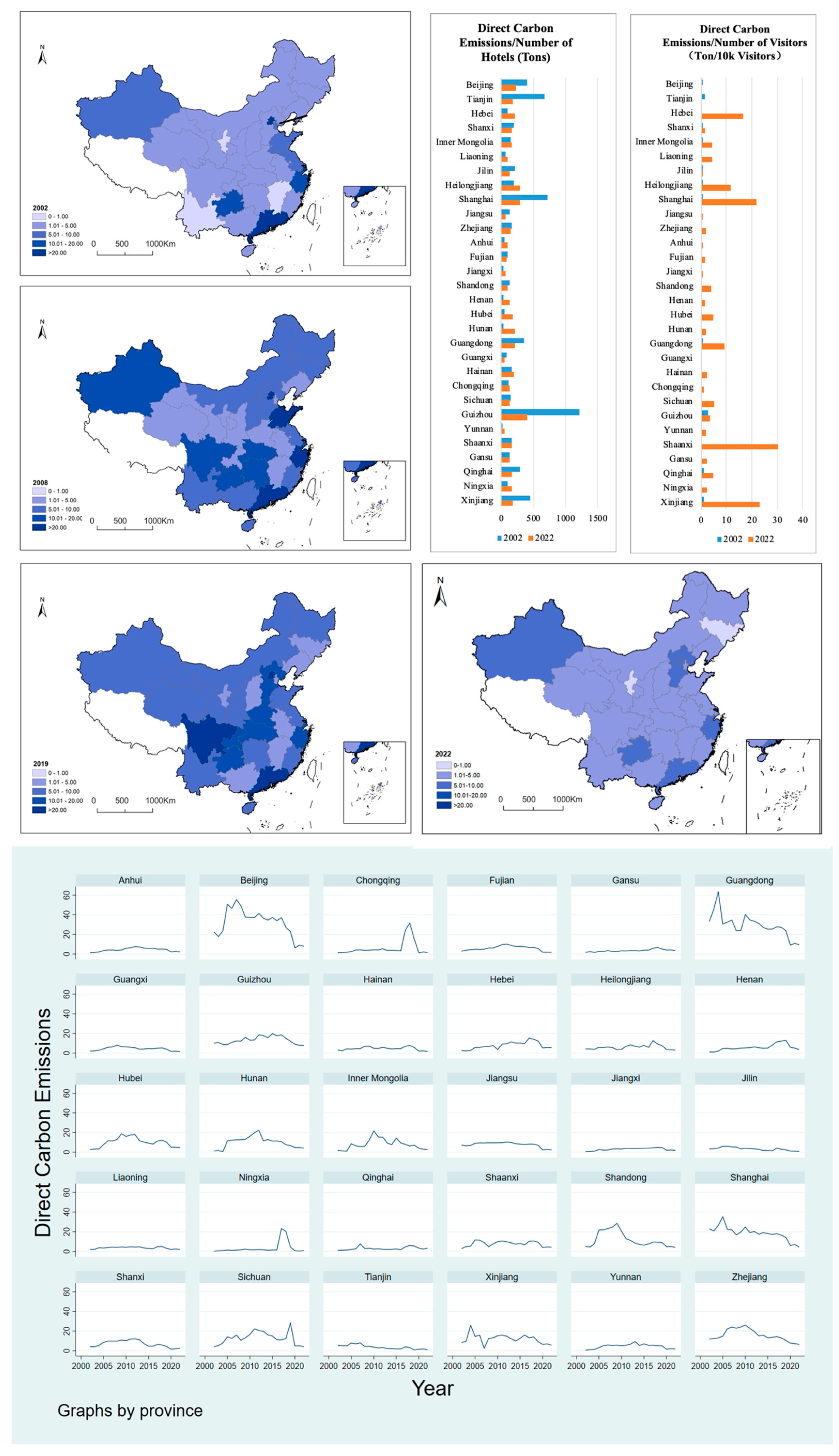
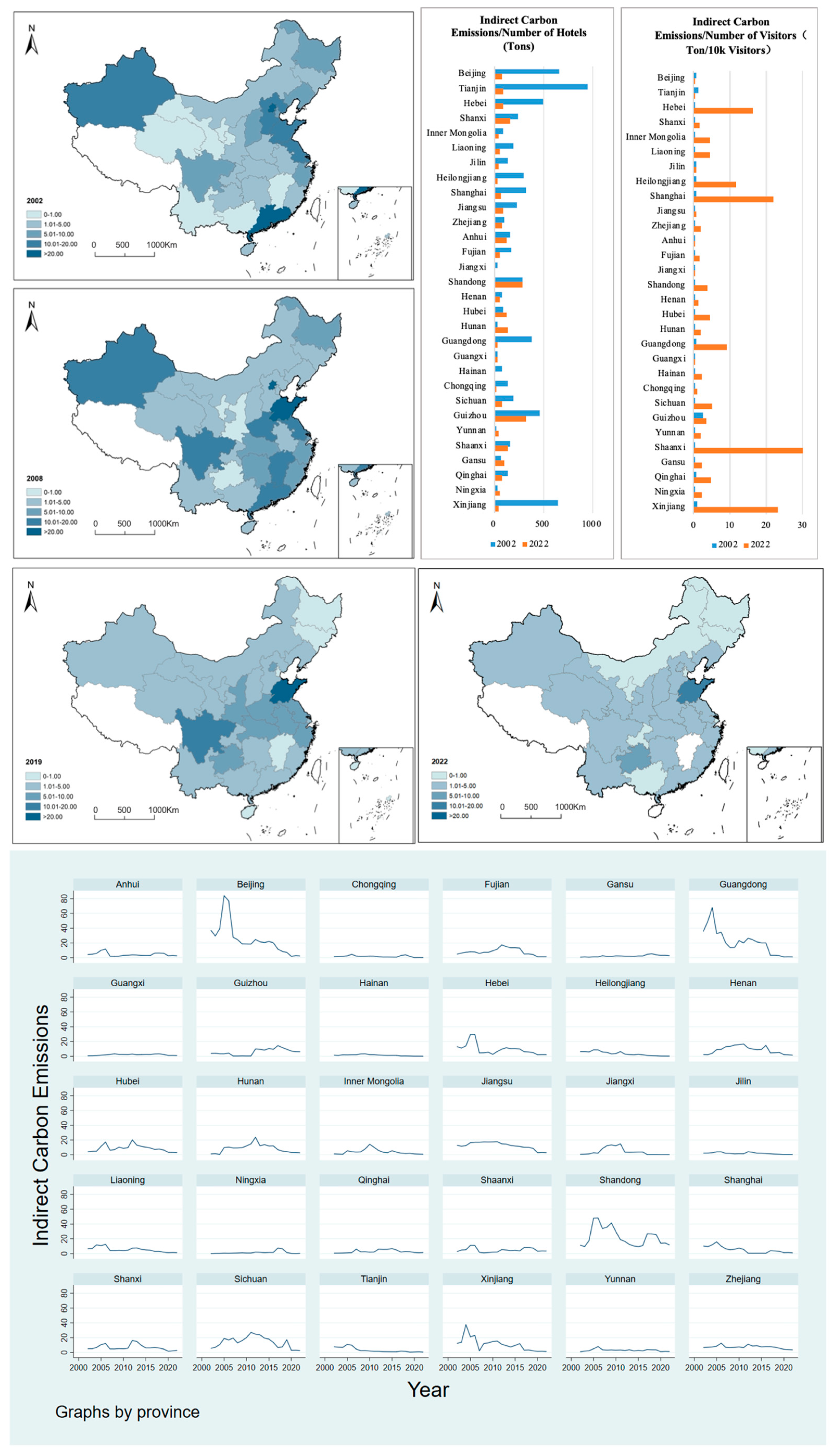
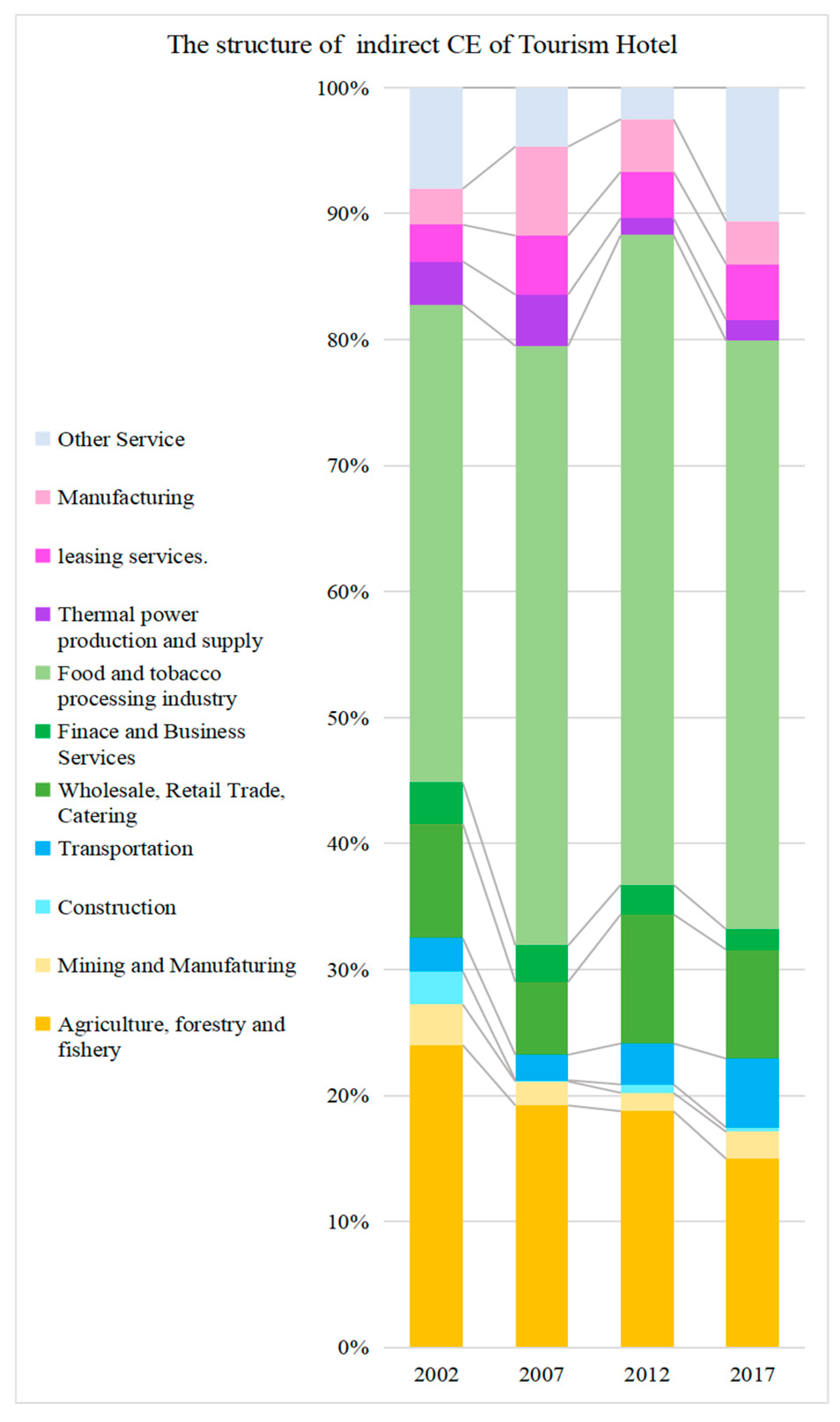

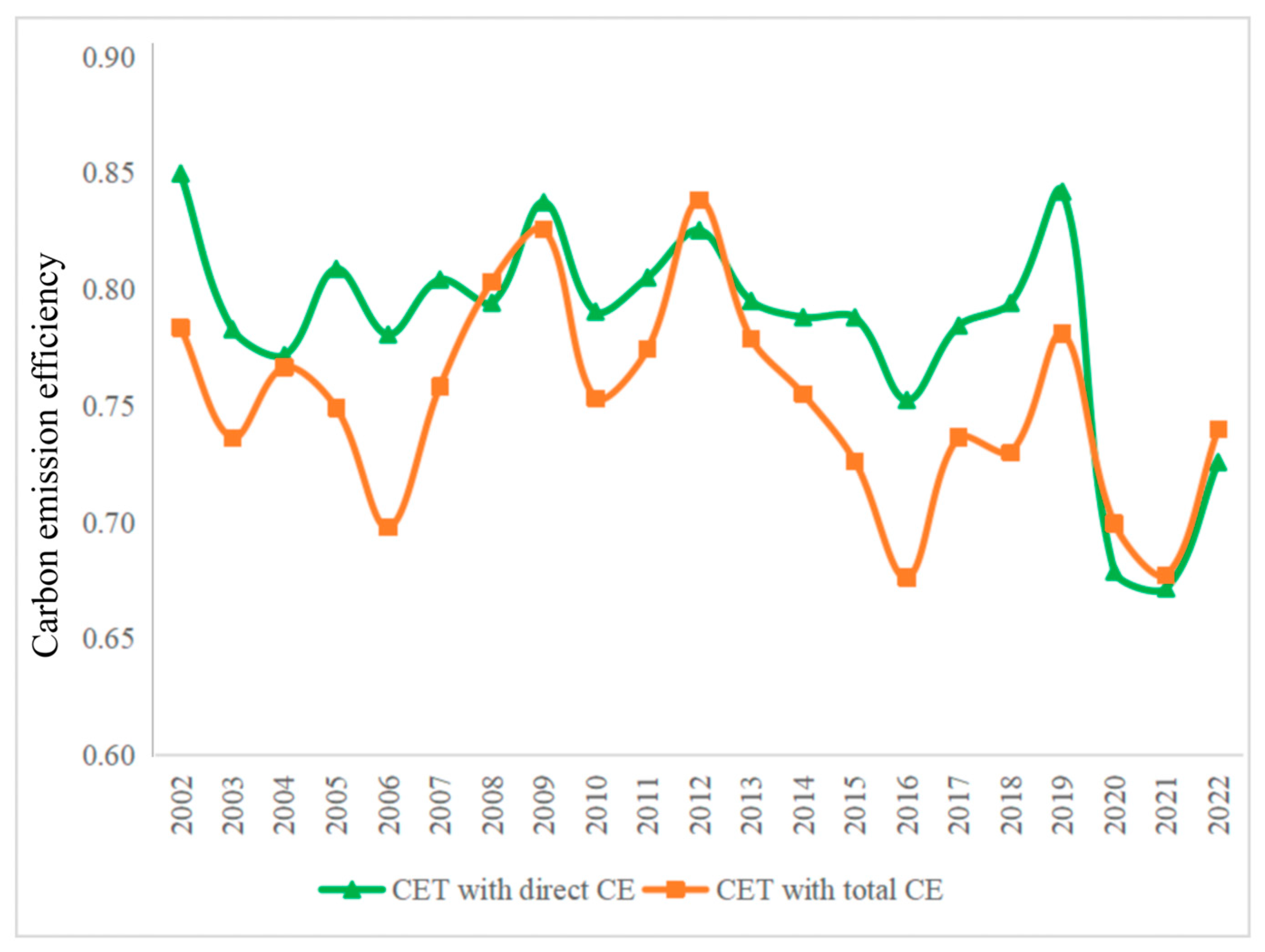
| Intermediate Use | ||||||||
|---|---|---|---|---|---|---|---|---|
| Industrial Sector | D1 | … | Dj | … | Dn | Final Use | Total Output | |
| Intermediate Input | DS1 | … | … | |||||
| DSi | … | … | ||||||
| DSn | … | … | ||||||
| Value added | … | … | ||||||
| Total input | … | … | ||||||
| Types | Indicators | Unit |
|---|---|---|
| Input | Labor | 10 thousand people |
| Investment | Million | |
| Output | Income | Million |
| Undesirable output | Direct/Total carbon emissions | Ton |
| Type | Variable | Mean | Std. Dev. | Min | Max |
|---|---|---|---|---|---|
| Direct Carbon Emissions | DC | 8.96 | 8.75 | 0.32 | 63.47 |
| Indirect Carbon Emissions | IDC | 7.31 | 8.98 | 0.09 | 83.95 |
| Efficiency of Direct Carbon Emissions | CETdirect | 0.78 | 0.32 | 0.17 | 4.01 |
| Efficiency of Total Carbon Emissions | CETtotal | 0.75 | 0.34 | 0.14 | 4.05 |
| Scale Effect | lnIncome | 12.60 | 0.98 | 9.14 | 14.81 |
| Technical Effect | lnEnergy | 10.51 | 0.75 | 7.38 | 12.79 |
| Structure Effect | TI | 0.37 | 0.17 | 0.00 | 0.84 |
| Regional Economic | lnGDP | 10.39 | 0.81 | 8.09 | 12.15 |
| Urbanization | UP | 0.54 | 0.15 | 0.14 | 0.90 |
| Water Resource | GPW | 7.04 | 1.24 | 3.95 | 9.75 |
| Energy Efficiency | lnGPE | 1.00 | 0.76 | 0.03 | 5.83 |
| Civilization | lnST | 13.26 | 0.90 | 10.01 | 14.85 |
| Traffic Conditions | lnHKM | 9.66 | 4.39 | −3.00 | 12.73 |
| Indicator | Unit | |
|---|---|---|
| X1 | Average altitude | m |
| X2 | Average temperature | °C |
| X3 | Average precipitation | mm |
| X4 | Forest coverage rate | % |
| X5 | Area of protected zone | % |
| X6 | Investment in environmental pollution control | Billion |
| X7 | Employed population | 10 k People |
| X8 | Internal expenditure of R&D funds | 10 k CNY |
| X9 | National technology market transaction volume | 10 k CNY |
| X10 | Jurisdictional area | 10 k Hectares |
| X11 | Number of domestic tourism organizations organized by travel agencies | 10 k People |
| X12 | Overall daily average of energy-saving and emission reduction policy search index | / |
| Coupling Relationship | Type | Characteristic | Quantity in 2002 | Quantity in 2022 |
|---|---|---|---|---|
| Income and Direct Carbon Emissions | Type I | Low-income, High-carbon emissions | 2 | 1 |
| Type II | High-income, High-carbon emissions | 5 | 2 | |
| Type III | Low-income Low-carbon emission | 22 | 19 | |
| Type IV | High-income, Low-carbon emissions | 1 | 8 | |
| Income and Indirect Carbon Emissions | Type I | Low-income, High-carbon emissions | 9 | 1 |
| Type II | High-income, High-carbon emissions | 6 | 1 | |
| Type III | Low-income, Low-carbon emission | 15 | 19 | |
| Type IV | High-income, Low-carbon emissions | 0 | 9 |
| Type | Variable | DC | IDC | CETdirect | CETtotal | ||||
|---|---|---|---|---|---|---|---|---|---|
| Conf | z | Conf | z | Conf. | z | Conf. | z | ||
| Scale Effect | lnIncome | 9.09 | 35.76 *** | 7.30 | 13.80 *** | 0.04 | 2.38 ** | 0.05 | 2.95 *** |
| Technology Effect | lnEnergy | −8.03 | −28.93 *** | −5.15 | −10.45 *** | 0.17 | 9.38 *** | 0.13 | 6.41 *** |
| Structure Effect | TI | 0.17 | 6.87 *** | −0.11 | −2.32 ** | 0.00 | 2.09 ** | 0.00 | 2.48 ** |
| Regional Economic | lnGDP | −1.80 | −4.28 *** | −1.46 | −1.15 | 0.13 | 4.66 *** | 0.12 | 4.15 *** |
| Urbanization | UP | 0.03 | 1.35 | 0.01 | 0.21 | 0.00 | 1.17 | 0.00 | 0.90 |
| Water Resource | lnGPW | −0.19 | −1.19 | −1.16 | −3.98 *** | −0.03 | −2.59 *** | −0.03 | −2.67 *** |
| Energy Efficiency | GPE | −0.09 | −0.22 | −0.09 | −0.13 | 0.11 | 4.04 *** | 0.09 | 3.02 *** |
| Civilization | lnST | −0.77 | −2.45 ** | −0.44 | −0.74 | −0.16 | −7.54 *** | −0.20 | −8.87 *** |
| Traffic Conditions | lnHKM | −0.72 | −7.47 *** | 0.46 | 2.21 ** | 0.00 | 0.45 | −0.01 | −1.26 |
| Year 2002 | Year 2005 | Year 2010 | Year2015 | Year2019 | Year 2022 | |||||||
|---|---|---|---|---|---|---|---|---|---|---|---|---|
| Y1 | Y2 | Y1 | Y2 | Y1 | Y2 | Y1 | Y2 | Y1 | Y2 | Y1 | Y2 | |
| X1 | 0.10 | 0.11 | 0.02 | 0.09 | 0.06 | 0.05 | 0.08 | 0.04 | 0.05 | 0.20 | 0.13 | 0.12 |
| X2 | 0.06 | 0.03 | 0.02 | 0.14 | 0.07 | 0.19 | 0.04 | 0.18 | 0.18 | 0.27 | 0.19 | 0.23 |
| X3 | 0.12 | 0.05 | 0.05 | 0.14 | 0.05 | 0.05 | 0.02 | 0.06 | 0.20 | 0.27 | 0.13 | 0.57 |
| X4 | 0.12 | 0.10 | 0.04 | 0.04 | 0.18 | 0.20 | 0.12 | 0.24 | 0.19 | 0.17 | 0.14 | 0.19 |
| X5 | 0.11 | 0.13 | 0.03 | 0.01 | 0.12 | 0.01 | 0.20 | 0.05 | 0.19 | 0.10 | 0.34 | 0.32 |
| X6 | 0.23 | 0.41 | 0.33 | 0.45 | 0.36 | 0.23 | 0.42 | 0.20 | 0.28 | 0.37 | 0.11 | 0.12 |
| X7 | 0.19 | 0.37 | 0.24 | 0.23 | 0.21 | 0.49 | 0.15 | 0.44 | 0.28 | 0.36 | 0.26 | 0.13 |
| X8 | 0.30 | 0.32 | 0.22 | 0.30 | 0.19 | 0.12 | 0.06 | 0.31 | 0.30 | 0.36 | 0.16 | 0.23 |
| X9 | 0.24 | 0.31 | 0.33 | 0.37 | 0.09 | 0.06 | 0.23 | 0.12 | 0.30 | 0.47 | 0.17 | 0.52 |
| X10 | 0.13 | 0.07 | 0.03 | 0.05 | 0.09 | 0.19 | 0.10 | 0.13 | 0.09 | 0.13 | 0.22 | 0.17 |
| X11 | 0.43 | 0.37 | 0.23 | 0.10 | 0.37 | 0.48 | 0.09 | 0.02 | 0.22 | 0.32 | 0.08 | 0.24 |
| X12 | 0.33 | 0.34 | 0.29 | 0.35 | 0.19 | 0.31 | 0.13 | 0.31 | 0.48 | 0.36 | 0.22 | 0.39 |
Disclaimer/Publisher’s Note: The statements, opinions and data contained in all publications are solely those of the individual author(s) and contributor(s) and not of MDPI and/or the editor(s). MDPI and/or the editor(s) disclaim responsibility for any injury to people or property resulting from any ideas, methods, instructions or products referred to in the content. |
© 2024 by the authors. Licensee MDPI, Basel, Switzerland. This article is an open access article distributed under the terms and conditions of the Creative Commons Attribution (CC BY) license (https://creativecommons.org/licenses/by/4.0/).
Share and Cite
Zhang, J.; Xia, B. Carbon Emissions and Its Efficiency of Tourist Hotels in China from the Supply Chain Based on the Input–Output Method and Super-SBM Model. Sustainability 2024, 16, 9489. https://doi.org/10.3390/su16219489
Zhang J, Xia B. Carbon Emissions and Its Efficiency of Tourist Hotels in China from the Supply Chain Based on the Input–Output Method and Super-SBM Model. Sustainability. 2024; 16(21):9489. https://doi.org/10.3390/su16219489
Chicago/Turabian StyleZhang, Jing, and Bing Xia. 2024. "Carbon Emissions and Its Efficiency of Tourist Hotels in China from the Supply Chain Based on the Input–Output Method and Super-SBM Model" Sustainability 16, no. 21: 9489. https://doi.org/10.3390/su16219489
APA StyleZhang, J., & Xia, B. (2024). Carbon Emissions and Its Efficiency of Tourist Hotels in China from the Supply Chain Based on the Input–Output Method and Super-SBM Model. Sustainability, 16(21), 9489. https://doi.org/10.3390/su16219489


_Li.png)




